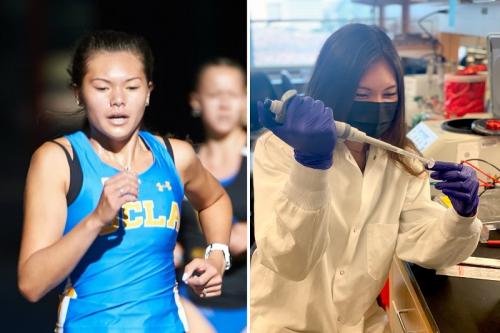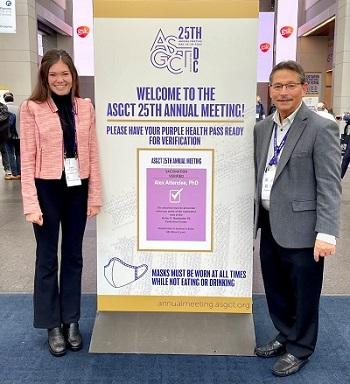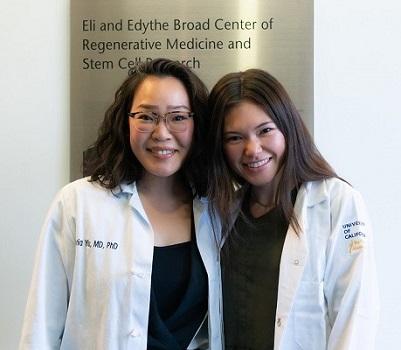
When it comes to identifying new gene therapies, she’s in it for the long run
Like any experienced distance runner, Grace McAuley always keeps her focus on the finish line — even if it’s out of sight. That’s what makes her such a promising young scientist.
In spring 2020, McAuley was a UCLA senior who was wrapping up four years on the Bruin track and cross-country teams. Not long after running her last race for UCLA, she joined the lab of Dr. Donald Kohn, a UCLA physician-scientist known for developing gene therapies for blood and immune disorders.
“I kept telling Grace she was too busy to join the lab, but she wouldn’t take no for an answer,” says Kohn, a member of the Eli and Edythe Broad Center of Regenerative Medicine and Stem Cell Research. “She told me track season was over, and that she wanted to join the lab, work here for two years, and then apply to M.D.-Ph.D. programs. I like people who know their own minds so well, so I brought her on.”
With no previous laboratory experience — “I actually didn’t even know how to pipette, one of the most basic skills there is,” she says — McAuley faced a steep learning curve. She logged long hours studying techniques and reading up on the latest research, determined to make herself an asset to scientists who had been immersed in the field for years.

McAuley soon found her stride. By the time she earned her bachelor’s degree, just a few months after joining the lab, the decision to keep McAuley on was a no-brainer, Kohn says. As a research technician, her job would be to support the more senior scientists who were pursuing gene editing as an approach for treating blood and immune disorders.
Then, an unexpected opportunity emerged: Dr. Nicola Wright, a pediatric hematologist and immunologist at Alberta Children’s Hospital Research Institute in Canada, asked Kohn if gene therapy could be used treat a rare and deadly genetic condition called CD3 delta severe combined immunodeficiency.
CD3 delta SCID is extremely rare in general, but the mutation that causes this disease is prevalent in the Mennonite community, of which there is a large population in Alberta. Most doctors will never see a patient with the disease, but Wright has treated several.
The CD3 delta SCID mutation makes patients’ blood stem cells unable to produce T cells. And without T cells, babies born with the disease are completely defenseless against infections. Currently, the only treatment is a bone marrow transplant, which can be risky and can take up to a year.
Because all cases of CD3 delta SCID are caused by a single mutation, McAuley suggested that base editing, a new and ultraprecise form of genome editing that changes a single DNA letter to fix a broken gene, could be a possible treatment. With a green light from Kohn, McAuley dove in to find out.
“I knew this project was a big deal and I felt so honored that Don even trusted me with it as a lowly new scientist,” McAuley says. “That felt like a leap of faith, and I really didn’t want to let him or these patients down.”
Kohn’s lab had never attempted base editing, so it was up to McAuley to figure out how to make it work. The problem stretched out in front of her like a long-distance run.
“In the beginning, base editing wasn't working for me, so I had to push through a lot of failure,” McAuley says. On days when things felt impossible, she applied the tenacity and perseverance she had honed through her running career.
“I probably don’t even know half of the times she was in the lab until 2 a.m. working,” says Kohn, who is also a distinguished professor of microbiology, immunology and molecular genetics in the UCLA College and of pediatrics and molecular and medical pharmacology at the David Geffen School of Medicine at UCLA. “She’s not the type to come in the next day and tell everyone how late she stayed; she’d just come back a few hours later and start again.”

Even as she split her time among the lab, organizing food drives, and working with UCLA faculty members to establish a new sickle cell disease center at UCLA Health, McAuley stayed engaged in her gene editing research. Eventually, she made a critical discovery, identifying a base editor that corrected the disease-causing mutation.
After further research and testing to ensure the approach was safe, McAuley and Kohn collaborated with UCLA colleagues to determine whether it would be effective at restoring T cell production.
Dr. Gloria Yiu — using a technique pioneered by UCLA’s Dr. Gay Crooks — introduced corrected blood stem cells into artificial thymic organoids, which enabled her to recreate the process by which blood stem cells give rise to T cells in a human organ called the thymus. The corrected blood stem cells were able to produce fully mature and functional T cells. And further experiments in mice indicated that the corrected stem cells could proliferate and survive long-term.
Taken together, the studies suggest that base editing could potentially serve as a one-time treatment that would enable patients with CD3 delta SCID to produce healthy T cells, essentially creating a functional immune system where there was none before.
Wright says the approach appeared to work even better than she expected it would. “To be able to stand in front of the families affected by this disease and tell them we’re going to have better treatment options in their lifetimes is amazing,” she says. “It just creates so much hope for all of us.”
A study detailing the remarkable findings was published March 20 in the journal Cell.
While the UCLA team is working with Wright to bring base editing to clinical trial for babies with CD3 delta SCID, McAuley is doing her best to stay involved while finishing up the first year of her M.D.-Ph.D. program at the UC San Diego School of Medicine. She hopes to one day follow in Kohn’s footsteps, by both treating patients and continuing to explore new therapies. Kohn has no doubt she’ll make that dream a reality.
“I call her Amazing Grace,” he said. “One of the wonderful things about being at UCLA is there are so many smart people here, but she’s really unique in her smarts, her capability and her drive.”
And while many first-year graduate students would be over the moon to have a paper published in a prestigious journal, McAuley remains focused on a bigger goal.
“The Cell paper is awesome, but it’s not the finish line,” she says. “The finish line is getting this therapy to the patients who need it. There’s still a lot of work to be done.”
